Clivia miniata
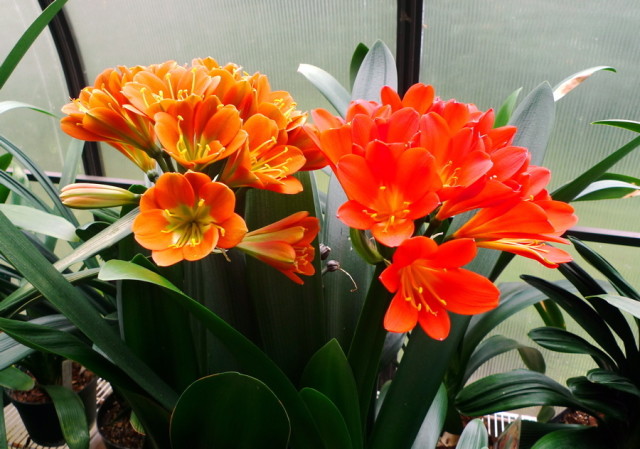
Two of Susan Kay’s best orange Clivia
When it’s rainy and gray outside and you’re stuck in Portland with no immediate tropical vacation in sight, there’s nothing quite so delightful as the sight of dazzling, hot orange flowers. Enter Clivia: a lovely South African plant that makes a fantastic houseplant and flowers right when we Pacific Northwesterners can really use a big dose of sunshine.

A selection of orange clivias displaying the desirable “chubby” leaf form, as well as some with green and yellow throats and some multi-petalled selections.
This South African relative of the Amaryllis surely must be one of the easiest houseplants to grow – and for those in frost-free climates, they are easy outdoor garden plants, too. But Clivia have a special allure for collectors who seek out uncommon species, rare flower colors and shapes, special leaf forms, and variegated foliage.
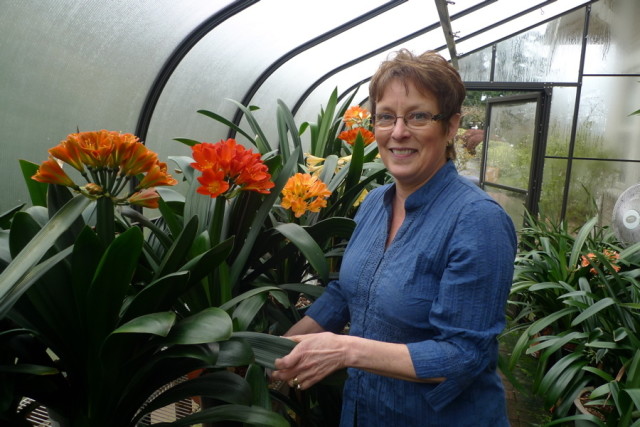
Susan Kay, with some of her fancy clivia hybrids
Fancy hybrids can now be found through specialty growers in exquisite shades of yellow, peach, apricot, coral, red, cream, and green, as well as multi-petaled types and variegated and chubby-leafed forms. Some collectors focus on other species like Clivia nobilis, C. gardenii, C. caulescens, and C. mirabilis.
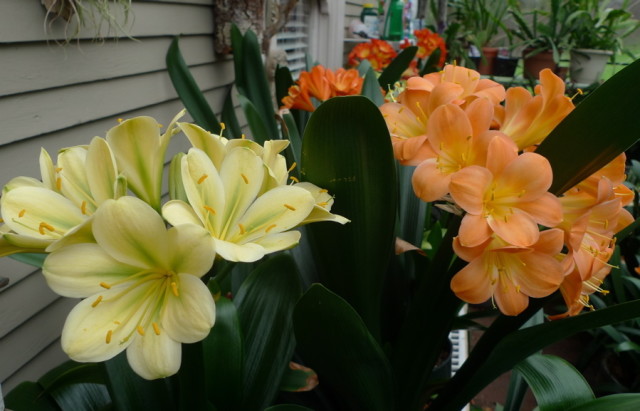
I was particularly smitten with this large-flowered yellow with a green veining, as well as the soft salmon Clivia behind it.
I visited Clivia collector and home breeder, Susan Kay, on a recent gray, rainy morning and gained a delightful glimpse into the marvels of this elegant and bright Amaryllis relative. We visited her seed-starting area and greenhouse and I learned some interesting tidbits about how she first fell for clivias, and what the clivia collectors’ "scene" is like:
KB: How long have you been growing and breeding clivia?
SK: I got my first clivia about 35 years ago, just a nice average orange one. I gave oodles of offsets from that plant to family and friends over the years. It wasn’t until about 10 years ago that I saw the yellow Clivia advertised in Park Seed. I ordered a number of yellow seeds from South Africa and started growing them. Soon after that more colors were being offered and I started importing from several breeders from South Africa, Japan and China… The first plants that I crossed should flower next year. I have sold some of my extra seed crosses on eBay and traded seed and pollen with Clivia internet friends.
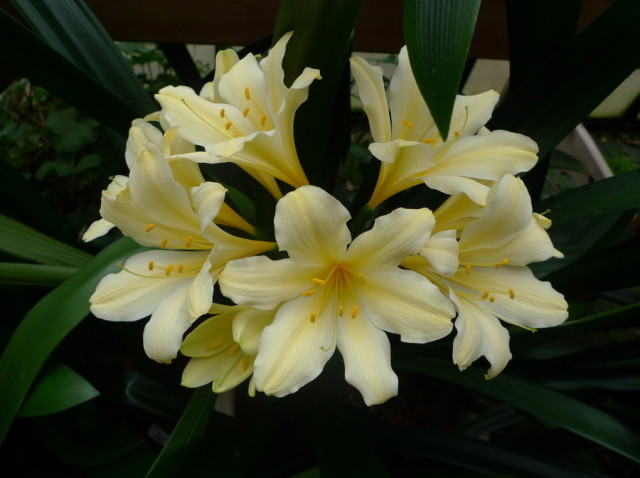
Yellow clivias are much sought-after among collectors. This soft yellow variation has deeper yellow veins.
KB: What’s the most expensive clivia plant – and seed – you’ve ever seen?
SK: There was a green one auctioned off for one of the societies for $6,000. In Japan a plant of perfect form and variegation may go as high as $20,000. I have sold very special multipetal seeds that I crossed for $100/seed (I hate to admit it. But there is a market.) The going rate for the green Hirao is about $1,000-$1,200 if you can find one. Near that for some of the Japanese imported multipetals you saw in the greenhouse.
Wow!
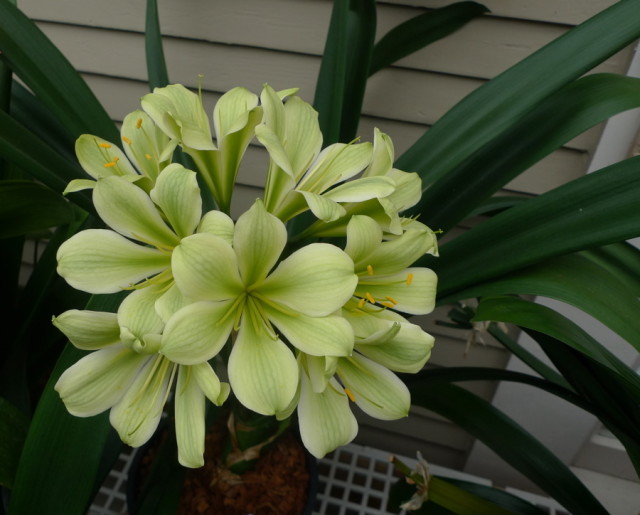
The rare green variety, Clivia ‘Hirao Green’, imported from Japan.
Yet while unusual Clivia are much sought-after, the common orange Clivia miniata is a winning plant, and very gratifying for beginners. It produces beautiful, bright orange, late winter/early spring flowers on stalks rising from glossy, dark green, strappy foliage.
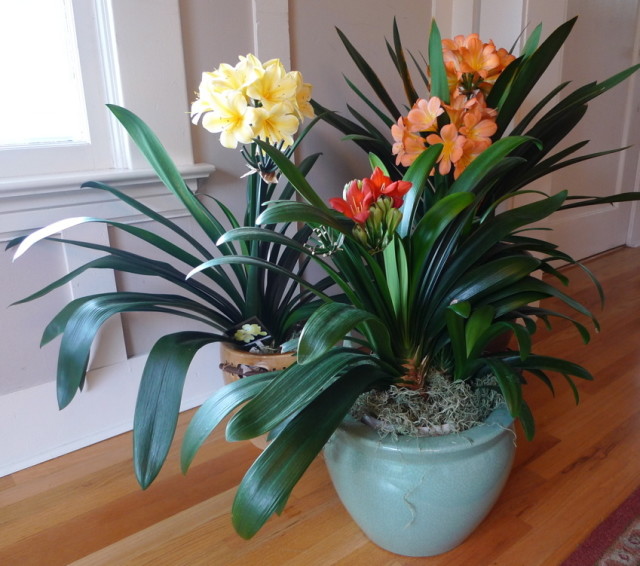
Elegant, tidy and dazzlingly colorful clivias make fantastic houseplants, particularly in a cooler part of the house or near an uninsulated window (anyone live in an old house?) If you have a cool greenhouse or mudroom, all the better! Keep your Clivia there until it sets buds, then bring it into a living room so you can enjoy the flowers for many weeks.
Native to South African woodlands and hillsides, where it grows beneath trees, Clivia miniata is easy to grow indoors, as long as it is kept out of direct summer sunlight. Filtered light or shade are best, and while it’s extremely adaptable, with fleshy roots that conserve water for months at a time, it does need to be kept in a cool place in fall and winter in order to flower. A cool entryway, unheated greenhouse or mudroom works well. Since they don’t need regular water, and going without water all fall is often suggested to help stimulate flowering, Clivias are said to be perfect for those with a second home that’s kept cool. But they’re also great for people with neglectful habits. I can attest to this, as I’ve left my plant unwatered for at least two months with no apparent ill effect!
{% display:image for:post image:7 align:right width:350 %}
For more US-based information, Susan suggests the following websites:
I also like the Clivia Society for care and cultivation information.
{% display:image for:post image:8 align:left width:350 %}
{% display:image for:post image:9 align:right width:350 %}
{% display:image for:post image:10 align:left width:350 %}
